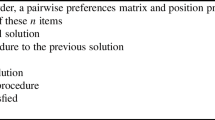Abstract
The linear ordering problem is an NP-hard combinatorial problem with a large number of applications. Contrary to another very popular problem from the same category, the traveling salesman problem, relatively little space in the literature has been devoted to the linear ordering problem so far. This is particularly true for the question of developing good heuristic algorithms solving this problem.
In the paper we propose a new heuristic algorithm solving the linear ordering problem. In this algorithm we made use of the sorting through insertion pattern as well as of the operation of permutation reversal. The surprisingly positive effect of the reversal operation, justified in part theoretically and confirmed in computational examples, seems to be the result of a unique property of the problem, called in the paper the symmetry of the linear ordering problem. This property consists in the fact that if a given permutation is an optimal solution of the problem with the criterion function being maximized, then the reversed permutation is a solution of the problem with the same criterion function being minimized.
Similar content being viewed by others
References
S. Chanas, B. Florkiewicz, and M. Galant-Pater, “Heuristic algorithms for the permutation method of the multiple attribute decision making,” Badania Operacyjne i Decyzje, Nr. 3, pp. 41–50, 1991.
S. Chanas, B. Florkiewicz, and M. Galant-Pater, “Computing aspects of the permutation method in the multiple attribute decision making.” Badania Operacyjne i Decyzje, Nr. 4, pp. 5–13, 1991.
S. Chanas and P. Kobylański, “Heuristic algorithm solving the problem of linear ordering,” Badania Operacyjne i Decyzje, Nr. 3, pp. 5–9, 1993.
M.R. Garey and D.S. Johnson, Computers and Intractability: A Guide to the Theory of NP-Completeness, Freeman: San Francisco, CA, 1979.
F. Glover, T. Klastorin, and D. Klingman, “Optimal weighted ancestry relationships”, Management Science, vol. 20, pp. B1190-B1193, 1974.
M. Grötschel, M. Jünger, and G. Reinrlt, “A cutting plane algorithm for the linear ordering problem,” Operations Research, vol. 32, no. 6, pp. 1195–1220, 1984.
M. Grötschel, M. Jünger, and G. Reinelt, “On the acyclic subgraph polytope,” Mathematical Programming, vol. 33, pp. 28–42, 1985.
Ch. Hwang and K. Yoon, “Multiple Attribute Decision Making, Methods and Applications, A State-of-the-Art-Survey,” Lecture Notes in Economics and Mathematical Systems 186, Springer-Verlag: Berlin-Heidelberg-New York, 1981.
R. Kaas, “A branch and bound algorithm for the acyclic subgraph problem,” European Journal of Operational Research, vol. 8, pp. 355–362, 1981.
B. Korte and W. Oberhofer, “Zwei Algorithmen zur Lösung eines komplexen Reihenfolgeproblems,” Unternehmensforschung, vol. 12, pp. 217–231, 1968.
H.W. LenstraJr., “The acyclic subgraph problem,” Report BW26 (1973), Mathematisch Centrum, Amsterdam.
J.K. Lenstra, “Sequencing by enumerative methods,” Mathematical Centre Tracts 69 (1977), Mathematisch Centrum, Amsterdam.
P.M. Pardalos and H. Wolkowicz (Eds.), “Quadratic Assignment and related problems,” DIMACS Series, vol. 16, American Mathematical Society, 1994.
H. Wessels, “Triangulation und Blocktriangulation von Input-Output-Tabellen,” Deutsches Institut für Wirtschaftsforschung: Beiträge zur Strukturforschung, Heft 63, Berlin, 1981.
Author information
Authors and Affiliations
Rights and permissions
About this article
Cite this article
Chanas, S., Kobylański, P. A new heuristic algorithm solving the linear ordering problem. Comput Optim Applic 6, 191–205 (1996). https://doi.org/10.1007/BF00249646
Received:
Issue Date:
DOI: https://doi.org/10.1007/BF00249646




